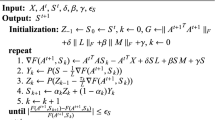Abstract
A weighted and convex regularized nuclear norm model is introduced to construct a rank constrained linear transform on feature vectors of deep neural networks. The feature vectors of each class are modeled by a subspace, and the linear transform aims to enlarge the pairwise angles of the subspaces. The weight and convex regularization resolve the rank degeneracy of the linear transform. The model is computed by a difference of convex function algorithm whose descent and convergence properties are analyzed. Numerical experiments are carried out in convolutional neural networks on CAFFE platform for 10 class handwritten digit images (MNIST) and small object color images (CIFAR-10) in the public domain. The transformed feature vectors improve the accuracy of the network in the regime of low dimensional features subsequent to dimensional reduction via principal component analysis. The feature transform is independent of the network structure, and can be applied to reduce complexity of the final fully-connected layer without retraining the feature extraction layers of the network.



Similar content being viewed by others
References
Ba, L.J., Caruana, R.: Do Deep Nets Really Need to be Deep? arxiv:1312.6184 (2013)
cuda-convnet. https://code.google.com/p/cuda-convnet
Deng, L., Yu, D.: Deep Learning: Methods and Applications. NOW Publishers, Breda (2014)
Denton, E., Zaremba, W., Bruna, J., LeCun, Y., Fergus, R.: Exploiting linear structure within convolutional networks for efficient evaluation. In: Advances in Neural Information Processing Systems (NIPS), pp. 1269–1277 (2014)
Hinton, G.: Learning multiple layers of representation. Trends Cognit. Sci 11(10), 428–434 (2007)
Jia, Y., Shelhamer, E., Donahue, J., Karayev, S., Long, J., Girshick, R., Guadarrama, S., Darrell, T.: Caffe: Convolutional Architecture for Fast Feature Embedding. arXiv preprint arXiv:1408.5093, (2014)
Krizhevsky, A.: Learning Multiple Layers of Features from Tiny Images. www.cs.toronto.edu/~kriz/index.htm (2009)
Krizhevsky, A., Sutskever, I., Hinton, G.: Imagenet classification with deep convolutional neural networks. Adv. Neural Inf. Process. Syst. 25, 1097–1105 (2012)
LeCun, Y., Bottou, L., Orr, G., Müller, K.: Neural Networks: Tricks of the Trade. Springer, Berlin (1998)
LeCun, Y., Bottou, L., Bengio, Y., Haffner, P.: Gradient-based learning applied to document recognition. Proc. IEEE 86(11), 2278–2324 (1998)
Qiu, Q., Sapiro, G.: Learning transformations for clustering and classification. J. Mach. Learn. Res. 16, 187–225 (2015)
Recht, B., Ré, C.: Parallel stochastic gradient algorithms for large-scale matrix completion. Math. Program. Comput. 5(2), 201–226 (2013)
Schmidhuber, J.: Deep Learning in Neural Networks: An Overview. arXiv:1404.7828v4 (2014)
Sironi, A., Tekin, B., Rigamonti, R., Lepetit, V., Fua, P.: Learning separable filters. IEEE Trans. Pattern Anal. Mach. Intell. 37(1), 94–106 (2015)
Tao, P.D., An, L.T.H.: Convex analysis approach to d.c. programming: theory, algorithms and applications. Acta Math. Vietnam. 22, 289–355 (1997)
Tao, P.D., An, L.T.H.: A DC optimization algorithm for solving the trust-region subproblem. SIAM J. Optim. 8(2), 476–505 (1998)
Watson, G.A.: Characterization of the subdifferential of some matrix norms. Linear Algebra Appl. 170, 33–45 (1992)
Yin, P., Xin, J.: PhaseLiftOff: an accurate and stable phase retrieval method based on difference of trace and Frobenius norms. Commun. Mathe. Sci. 13(2), 1033–1049 (2015)
Yin, P., Xin, J.: Iterative \(\ell _1\) minimization for non-convex compressed sensing. J. Comput. Math 35(4), 437–449 (2017)
Yu, D., Deng, L.: Automatic Speech Recognition: A Deep Learning Approach. Signals and Communications Technology. Springer, Berlin (2015)
Acknowledgements
The authors wish to thank Dr. Xiangxin Zhu of Google Inc., Dr. Yang Yang, and Dr. Xin Zhong for helpful conversations on DNN and CAFFE.
Author information
Authors and Affiliations
Corresponding author
Additional information
This work was partially supported by NSF Grants DMS-1222507, DMS-1522383, IIS-1632935.
Rights and permissions
About this article
Cite this article
Yin, P., Xin, J. & Qi, Y. Linear Feature Transform and Enhancement of Classification on Deep Neural Network. J Sci Comput 76, 1396–1406 (2018). https://doi.org/10.1007/s10915-018-0666-1
Received:
Revised:
Accepted:
Published:
Issue Date:
DOI: https://doi.org/10.1007/s10915-018-0666-1
Keywords
- Linear feature transform
- Difference of weighted nuclear norms
- Low dimensional features
- Enhanced classification




